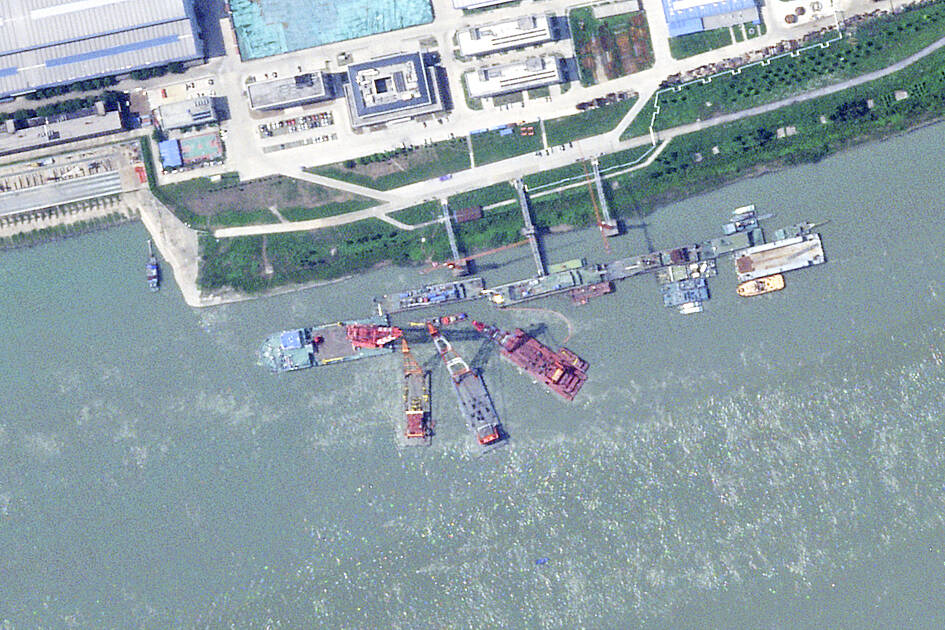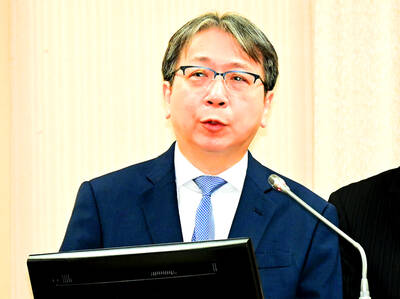Satellite imagery showed that China’s newest nuclear-powered attack submarine sank alongside a pier while under construction, a senior US defense official said on Thursday.
The sinking of China’s first Zhou-class submarine represents a setback for Beijing as it continues to build out the world’s largest navy. Beijing has become increasingly assertive in pursuing its claim to virtually the entire South China Sea, which is crucial to international trade.
The submarine likely sank between May and June, when satellite images showed cranes that would be necessary to lift it off the bottom of the river, said the official, who spoke on condition of anonymity to provide details about the submarine loss.

Photo: AP
China has been building up its naval fleet at a breakneck pace, and the US considers China’s rise one of its main future security concerns.
A Chinese Ministry of Foreign Affairs spokesperson yesterday said that he was not familiar with the topic and did not provide any information when asked about it at a news conference in Beijing.
The US official said it was “not surprising” that China’s navy would conceal it. The submarine’s current status is unknown.
The identification of the sunken nuclear submarine was first reported by the Wall Street Journal.
Thomas Shugart, a former US Navy submariner and an analyst at the Center for a New American Security, first noticed the incident involving the submarine in July, though it was not publicly known at the time that it involved the new Zhou-class vessel.
Satellite images from Planet Labs PBC analyzed by The Associated Press show what appears to be a submarine docked at the Shuangliu shipyard on the Yangtze River before the incident.
An image taken on June 15 appears to show the submarine either fully or partially submerged just under the river’s surface, with rescue equipment and cranes surrounding it. Booms surround it to prevent any oil or other leaks from the vessel.
A satellite image taken on Aug. 25 shows a submarine back at the same dock as the submerged vessel. It is not clear if it was the same one.
It remains unclear if the affected submarine had been loaded with nuclear fuel or if its reactor was operating at the time of the incident. However, there has been no reported release of radiation in the area in the time since.
China as of last year operated six nuclear-powered ballistic missile submarines, six nuclear-powered attack submarines and 48 diesel-powered attack submarines, a US military report said.
News of the submarine’s sinking comes as China this week conducted a rare launch of an intercontinental ballistic missile into international waters in the Pacific Ocean. Experts say it marked the first time Beijing had conducted such a test since 1980.

The US government has signed defense cooperation agreements with Japan and the Philippines to boost the deterrence capabilities of countries in the first island chain, a report by the National Security Bureau (NSB) showed. The main countries on the first island chain include the two nations and Taiwan. The bureau is to present the report at a meeting of the legislature’s Foreign Affairs and National Defense Committee tomorrow. The US military has deployed Typhon missile systems to Japan’s Yamaguchi Prefecture and Zambales province in the Philippines during their joint military exercises. It has also installed NMESIS anti-ship systems in Japan’s Okinawa

‘WIN-WIN’: The Philippines, and central and eastern European countries are important potential drone cooperation partners, Minister of Foreign Affairs Lin Chia-lung said Minister of Foreign Affairs Lin Chia-lung (林佳龍) in an interview published yesterday confirmed that there are joint ventures between Taiwan and Poland in the drone industry. Lin made the remark in an exclusive interview with the Chinese-language Liberty Times (the Taipei Times’ sister paper). The government-backed Taiwan Excellence Drone International Business Opportunities Alliance and the Polish Chamber of Unmanned Systems on Wednesday last week signed a memorandum of understanding in Poland to develop a “non-China” supply chain for drones and work together on key technologies. Asked if Taiwan prioritized Poland among central and eastern European countries in drone collaboration, Lin

ON ALERT: Taiwan’s partners would issue warnings if China attempted to use Interpol to target Taiwanese, and the global body has mechanisms to prevent it, an official said China has stationed two to four people specializing in Taiwan affairs at its embassies in several democratic countries to monitor and harass Taiwanese, actions that the host nations would not tolerate, National Security Bureau (NSB) Director-General Tsai Ming-yen (蔡明彥) said yesterday. Tsai made the comments at a meeting of the legislature’s Foreign Affairs and National Defense Committee, which asked him and Minister of National Defense Wellington Koo (顧立雄) to report on potential conflicts in the Taiwan Strait and military preparedness. Democratic Progressive Party (DPP) Legislator Michelle Lin (林楚茵) expressed concern that Beijing has posted personnel from China’s Taiwan Affairs Office to its

BACK TO WORK? Prosecutors said they are considering filing an appeal, while the Hsinchu City Government said it has applied for Ann Kao’s reinstatement as mayor The High Court yesterday found suspended Hsinchu mayor Ann Kao (高虹安) not guilty of embezzling assistant fees, reducing her sentence to six months in prison commutable to a fine from seven years and four months. The verdict acquitted Kao of the corruption charge, but found her guilty of causing a public official to commit document forgery. The High Prosecutors’ Office said it is reviewing the ruling and considering whether to file an appeal. The Taipei District Court in July last year sentenced Kao to seven years and four months in prison, along with a four-year deprivation of civil rights, for contravening the Anti-Corruption